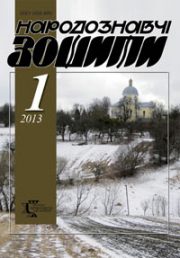The Ethnology Notebooks. 2025. № 5 (185), 1199—1209
UDK76:7.04:2-135-055.2:929А.Бокотей
THE IMAGE OF A WOMAN IN ANDRIY BOKOTEY’S GRAPHIC WORKS OF THE 1960s: DEFINING ARTISTIC DOMINANTS
SMAKOVA Lyudmyla
- ORCID ID: https://orcid.org/0000-0001-7226-1793
- Lecturer, postgraduate student,
- Lviv National Academy of Arts,
- Department of Art Glass,
- 38, Kubiyovycha Str., 79011, Lviv, Ukraine,
- Contacts: e-mail: lyudmila_smakova@lnam.edu.ua
Abstract. Introduction. The article explores the little-studied early graphic works of Andriy Bokotey from the 1960s, focusing in particular on the representation of the female image. It also outlines the socio-historical context of the 1960s in the USSR, the informal school of Karlo Zvirynskyi, and the artist’s reference to folk traditions.
Problem Statement. The absence of an in-depth art historical analysis of Bokotey’s selected early works in current academic discourse has highlighted the need for their detailed study.
Purpose.The aim of the research is to identify the artistic dominants in Andriy Bokotey’s graphic works of the 1960s.
Methods. The study employs comparative, formal, iconographic, stylistic, contextual, and typological methods of analysis.
Results. The article focuses on three main types of female imagery in Bokotey’s graphic art: the woman in domestic space, the model as an artistic object, family members. Works such as Mrs. Bronya, The Housewife, The Pianist, Seated Model, and Sister Mariia, among others, are examined in detail. The analysis reveals key artistic dominants in the depiction of women: laconic expression, decorativeness, psychological depth, and expressive generalization of form. Special attention is given to the use of monotype and linocut techniques, which enabled the artist to achieve high expressiveness.
Conclusion. The research confirms the synthesis of influences from Karlo Zvirynskyi’s school and the expressionist tendencies of Roman Selskyi in Bokotey’s graphic works. This is manifested in a departure from realistic canons in favor of formal simplification, the use of line and plane, and a shift in emphasis from external idealization to internal content and psychological depth of the image. For the first time, this study offers a systematic analysis and publication of archival materials, helping to fill a gap in the study of Andriy Bokotey’s legacy and Lviv graphic art of the 1960s, and contributing to further exploration of the artist’s creative phenomenon.
Keywords: the works of Andriy Bokotey, Lviv graphic art, image of a woman, composition, stylistics, iconography, artistic and imagery dominants.
Received 8.09.2025
REFERENCES
- Lahutenko, O. (2007). Graphein. Graphics: Essays on the history of Ukrainian graphics of the 20th century. Kyiv. Retrieved from: https://irbis-nbuv.gov.ua/cgi-bin/ua/elib.exe?C21COM=S&I21DBN=UKRLIB&S21CNR=20&S21P03=FF=&S21STR=ukr0004970 (Last accessed: July 31, 2025) [in Ukrainian].
- Yatsiv, R. (1992). Lviv graphics 1945—1990: Traditions and innovation. Kyiv: Naukova dumka [in Ukrainian]
- Vavrukh, M. (2018). Lviv graphics of the second half of the 1960s — early 1970s through the prism of national self-identification and its influence on the generation of artists of the late 20th — early 21st centuries. Ethnololy notebooks, (2) 140, 508—515. ISSN 1028-5091. DOI: https://nz.lviv.ua/archiv/2018-2/31.pdf (Last accessed: April 21, 2025) [in Ukrainian].
- Som-Serdiukova, O. (2020). Karlo Zvirynskyi and his «underground academy»: Reflections of cultural memory. ART-Platforma, 2 (2), 117—137. DOI: https://doi.org/10.51209/platform.2.2.2020.117-137 (Last accessed: August 2, 2025) [in Ukrainian].
- Bratyuk, N. (2020). Expressionist tendencies of the 1960s in the work of the followers of Karlo Zvirynskyi’s school: Petro Markovych and Zenoviy Flynta. Ethnololy notebooks, (4) 54, 892—906. DOI: https://doi.org/10.15407/nz2020.04.892 (Last accessed: August 2, 2025) [in Ukrainian].
- Matkovska, I. (2017). The influence of the worldview and artistic principles of Roman Selskyi and Karlo Zvirynskyi on the formation of the creative personality of Zenovii Flynta. Visnyk of the Lviv National Academy of Arts, 31, 284—294. DOI: https://doi.org/10.5281/zenodo.573925 [in Ukrainian].
- Mysiuha, B. (2019). The hermetic circle of Karlo Zvirynskyi. Drohobych: Kolo [in Ukrainian].
- Fedoruk, O. (2008). Maestro of artistic glass Andriy Bokotey: A monograph. Kyiv: Lybid [in Ukrainian].
- Sydorenko, V. (2008). Visual art from avant-garde shifts to contemporary directions: Development of visual art in Ukraine in the 20th—21st centuries. Kyiv: VKh [studio]. Retrieved from: https://www.mari.kiev.ua/sites/default/files/inline-images/pdfs/Sydorenko.pdf (Last accessed: April 21, 2025) [in Ukrainian].







